A new monument in memory of the victims of the genocide of Hutu ethnic group people in 1972 has just been erected in Nyambeho valley in Giheta, on the border between Gitega and Giheta communes. The surrounding population speaks about speculation.
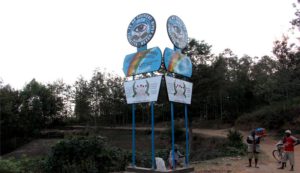
The brand new monument.
At the edge of Bujumbura-Gitega road, in the valley of Nyambeho stream, a few meters away, a brand new iron monument of more than 5m high challenges the old monument (a stele belonging to another association that fights for the recognition of genocide against Hutu ethnic group people). According to different sources, it was built in the morning of 21 September by “unknown people”. With sky-blue color and two faces, the signs are visible on both sides. At the top, there is an eye in tears staring at passers-by with words like: I remember, never again, “Zingatia” (Always remember).
A slogan (Before 1972 and after) of the Collective of Survivors and Victims of the 1972 Hutu Genocide surrounds this bitterly weeping eye. Despite its imposing shape and its bright color, the population of Giheta and Gitega is surprised that it was built without them being associated or consulted. Asked, several residents of the area said that these monuments built side by side sow rather trouble among the victims and survivors of “genocide”.
“Nobody has ever explained what it means. May those who can read tell us that it is a monument for the victims of 1972, “said a septuagenarian.
For this man who says he lost his uncle in 1972, the construction of this monument, while there was another, older, shows that the common reading of the events that have plunged Burundians into mourning is still far.
“If they defend the same cause, why do they erect two monuments on the same site? He wonders.
This septuagenarian is not the only one who wonders about the merit of this hastily built monument, of which nobody wanted to explain the meaning.
“It’s for their interests and not ours. These two associations should get along and come to show us the real and the false monument. Otherwise it is confusing us,” said Joseph, a resident of Gitega commune near Nyambeho.
“The disagreement was predictable!”
For many, the construction of this monument next to another does not surprise anyone.
“We were sure that this disagreement would eventually occur seeing how two groups were fighting over the same cause,” said a woman who became a widow in 1972. Speaking about “disagreements” this woman refers to two groups: that of François-Xavier Nsabimana which came to this Nyambeho site on April 28 and another group of Déogratias Nkinahamira which came the next day.
“Xavier told us that he and his companions are the only ones who are officially recognized and that we must chase anyone else who would come there saying they belong to the Collective of Survivors and Victims of the Hutu Genocide. In the space of 24 hours, another group (same slogan, same acronym) came and gave us the same injunctions, “said a bicycle taxi driver met on the spot.
“That they quarrel is normal. They should however let our parents rest in peace,” says Bernard, recalling that his father was thrown into a pit on the same Nyambeho site. People say they do not understand this conflict between two organizations that theoretically fight for the same cause.
“They put it here without warning us. If a thief comes tomorrow and steals metal sheets and metal tubes of this monument, they will accuse people of being supporters of this or that other party,” says Isidore.
Hearing what the population says, many doubt the good faith of these two associations that look daggers at each other.
“These leaders of both organizations are guided by self interests rather than the interest of the people,” they say.
Reactions
Bishop Jean Louis Nahimana: “One cannot be judge and defendant at the same time.”
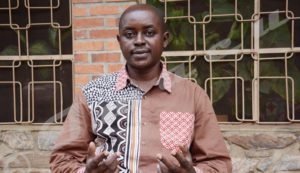 For the chairman of the Truth and Reconciliation Commission (CVR), the designers of the monument were too quick to refer to the 1972 killings as “genocide”. “CVR has not yet ruled on the classification of crimes committed in Burundi”. Jean Louis Nahimana says those people have advanced the work of the commission. He calls for more patience and appeals to them to wait for the conclusions of the work of the commission. However, Bishop Nahimana finds it normal that members of a community come together to defends their rights. The problem arises when they give themselves the prerogatives to draw conclusions. Bishop Jean Louis Nahimana explains that one cannot be judge and defendant at the same time. For this kind of situation, the risk is seeing one party making the past sufferings of the people its own. “All ethnic communities have been victims of their identities in all the crises that have plunged Burundians into mourning.”
For the chairman of the Truth and Reconciliation Commission (CVR), the designers of the monument were too quick to refer to the 1972 killings as “genocide”. “CVR has not yet ruled on the classification of crimes committed in Burundi”. Jean Louis Nahimana says those people have advanced the work of the commission. He calls for more patience and appeals to them to wait for the conclusions of the work of the commission. However, Bishop Nahimana finds it normal that members of a community come together to defends their rights. The problem arises when they give themselves the prerogatives to draw conclusions. Bishop Jean Louis Nahimana explains that one cannot be judge and defendant at the same time. For this kind of situation, the risk is seeing one party making the past sufferings of the people its own. “All ethnic communities have been victims of their identities in all the crises that have plunged Burundians into mourning.”
Ac Genocide: “A non-reconciling monument”
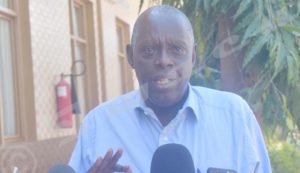 Térence Mushano, president of Ac Genocide, does not mince his words: “It is a discriminatory and non-reconciling monument.” For him, the events of 1972 did not claim lives of Hutu ethnic group victims only. “Who does not know that Tutsi people were massacred in Rumonge or Makamba during the first days? Only afterwards, the army of the time killed a lot of Hutu people in cold blood.”
Térence Mushano, president of Ac Genocide, does not mince his words: “It is a discriminatory and non-reconciling monument.” For him, the events of 1972 did not claim lives of Hutu ethnic group victims only. “Who does not know that Tutsi people were massacred in Rumonge or Makamba during the first days? Only afterwards, the army of the time killed a lot of Hutu people in cold blood.”
For Mr. Mushano, there must be memorials wherever there have been massacres so that they should never happen again. “Erecting a monument for the 1972 crisis would be consensual,” he says.
Gérard Nibigira: “Two monuments in one place, unacceptable. ”
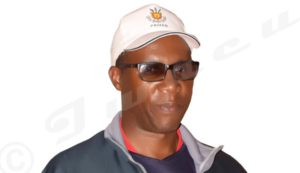 “The administration will not tolerate two monuments for the same cause in one place,” says Gerard Nibigira, senior advisor to the governor of Gitega. For the time being, he proposed to the concerned people to consult the administrator of Giheta to find a common ground. In case of absence of consensus between the two parts, the authorities will be forced to demolish one of the monuments. “The construction of monuments should not be messy. The governor is ready to receive them to help solve this issue,” he says.
“The administration will not tolerate two monuments for the same cause in one place,” says Gerard Nibigira, senior advisor to the governor of Gitega. For the time being, he proposed to the concerned people to consult the administrator of Giheta to find a common ground. In case of absence of consensus between the two parts, the authorities will be forced to demolish one of the monuments. “The construction of monuments should not be messy. The governor is ready to receive them to help solve this issue,” he says.
François-Xavier Nsabimana: “We have changed our logo”
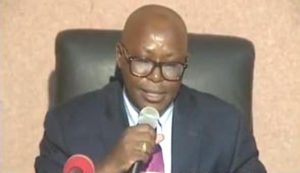 François-Xavier Nsabimana, president of the International Collective of Victims and Survivors of the 1972 Hutu Genocide, says to have heard about this monument. However, he does not know who erected it and their motives. “This association whose name is mentioned on the sign differs from that of which I am the president. Ours has an international aspect.” As for the resemblance of the logo of the placard with that of his association, he says: “We have changed our logo. We are no longer together with the initiators of this project.”
François-Xavier Nsabimana, president of the International Collective of Victims and Survivors of the 1972 Hutu Genocide, says to have heard about this monument. However, he does not know who erected it and their motives. “This association whose name is mentioned on the sign differs from that of which I am the president. Ours has an international aspect.” As for the resemblance of the logo of the placard with that of his association, he says: “We have changed our logo. We are no longer together with the initiators of this project.”
Written by Jean Noël Manirakiza & Arnaud Igor Giriteka and
Translated by Pierre Emmanuel Ngendakumana


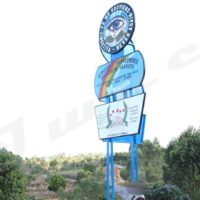
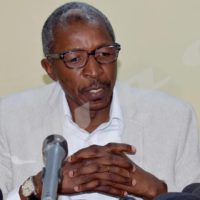
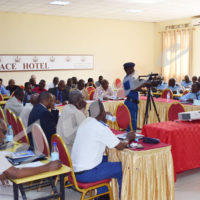
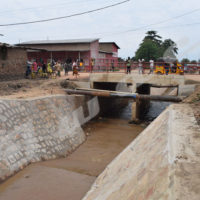













 IWACU Open Data
IWACU Open Data

